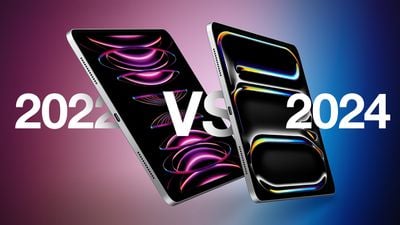[ad_1]
Apple’s new iPad Pro models come almost a year and a half after their predecessors, offering 25 significant changes and upgrades.

The 2022 iPad Pro was a minor upgrade that added the M2 chip and Apple Pencil hover, as well as support for Wi-Fi 6E, Bluetooth 5.3, and Smart HDR 4. The 2024 refresh is much more substantial, with more than two dozen changes and generation-over-generation improvements.
The 2022 iPad Pro models have now been discontinued by Apple, but they may still be found refurbished and with third-party resellers for lower prices. As such, some customers may be weighing up whether to buy the 2022 iPad Pro or the new 2024 models.
The iPad Pros from 2022 and 2024 share many of their key features, so should you consider buying or sticking with the older model to save money? This breakdown also serves as a way to clearly see all the differences that the new iPad Pro brings to the table.
| iPad Pro (2022) | iPad Pro (2024) |
|---|---|
| 11- or 12.9-inch display | 11- or 13-inch display |
| Liquid Retina or Liquid Retina XDR display LED or mini-LED backlit display with IPS |
Ultra Retina XDR display Tandem OLED |
| SDR brightness: 600 nits max | SDR brightness: 1000 nits max |
| Nano-texture display glass option on 1TB and 2TB models | |
| M2 chip (5nm, N5P) | M4 chip (3nm enhanced, N3E) |
| 8-core CPU | 9- or 10-core CPU |
| Hardware-accelerated ray tracing | |
| Hardware-accelerated H.264, HEVC, ProRes, and ProRes RAW | Hardware-accelerated 8K H.264, HEVC, ProRes, and ProRes RAW |
| ProRes encode and decode engine | ProRes encode and decode engine AV1 decode |
| 100GB/s memory bandwidth | 120GB/s memory bandwidth |
| Improved thermal design with graphite sheets and copper | |
| 10MP ƒ/2.4 Ultra Wide camera | |
| 2x optical zoom out and digital zoom up to 5x | Digital zoom up to 5x |
| ProRes video recording up to 4K at 60 fps with external recording | |
| True Tone flash | Adaptive True Tone flash |
| Rear ambient light sensor | |
| 12MP Ultra Wide front-facing camera | Landscape 12MP Ultra Wide front-facing camera |
| Sub-6GHz and mmWave 5G support | Sub-6GHz 5G support only |
| Physical SIM card slot | eSIM only |
| Depth: 5.9mm or 6.4mm | Depth: 5.3mm or 5.1mm |
| Weight: 1.03 pounds (466 grams) or 1.5 pounds (682 grams) | Weight: 0.98 pounds (444 grams) or 1.28 pounds (579 grams) |
| Supports Apple Pencil (USB‑C) and Apple Pencil (2nd generation) | Supports Apple Pencil (USB‑C) and Apple Pencil Pro |
| Supports Magic Keyboard for iPad and Smart Keyboard Folio | Supports Magic Keyboard for iPad Pro (M4) |
| Available with 128GB, 256GB, 512GB, 1TB, and 2TB storage | Available with 256GB, 512GB, 1TB, and 2TB storage |
| Available in Silver and Space Gray | Available in Silver and Space Black |
Overall, the new iPad Pro is an unusually significant upgrade over the previous generation, offering a large number of improvements that meaningfully improve the hardware experience with the device. The move to a high-end OLED display, thinner and lighter design, Adaptive True Tone flash, and landscape 12MP Ultra Wide front-facing camera are noticeable improvements that almost all users will benefit from. Features like the M4 chip, nano-texture display option, and Apple Pencil Pro support have the potential to enhance specific tasks and processes with the device, which could be particularly important to the likes of content creators and digital artists.
However, it is important to note that the new iPad Pro does not have any software advantages over previous versions of the device. Upgrading to the latest model is unlikely to dramatically change workflows, but it should offer a better overall experience. Users with an older iPad Pro, such as a 2018 model or older, have considerably more to gain by upgrading.
[ad_2]
Source Article Link

